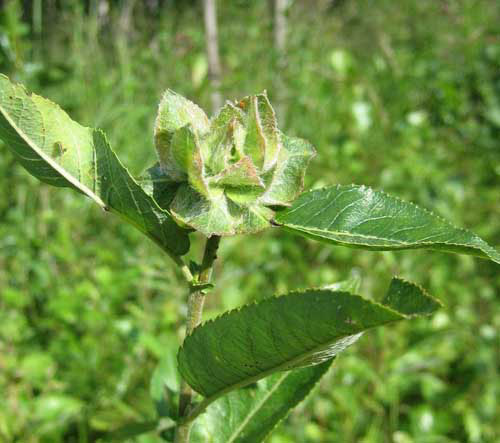 Alaska Science
Willow rose hosts insect drama
within
Alaska Science
Willow rose hosts insect drama
within
By NED ROZELL
July 21, 2010
Wednesday
From the more-you-look-the-more-you-see file, I present the willow
rose.
The willow rose is lovely, green and unexpected, its whirled
petals gracing the top of Alaska willows like the most delicate
blossom in the cooler of a flower shop. But this rose is cultivated
by an insect that manipulates the poor willow for both food and
shelter, often at a price to the bug that seems worse than death.
 A willow rose, formed
by an insect.
A willow rose, formed
by an insect.
Photo by Tommi Nyman, University of Eastern Finland
Willow roses often appear on Barclay willows, one of 33 species
of Alaska's most numerous trees. The Barclay, named for an English
botanist who sailed the west coast of America in 1835-1841, is
a common willow on riverbanks from the Yukon River southward
in Alaska. Because it's hard to tell one willow from another,
the presence of willow roses helps botanists know they are looking
at a Barclay.
A fly about the size and shape of a small mosquito is responsible
for altering the willow to its liking to create the willow rose.
In springtime, after the snow is gone but before willow buds
burst, a female willow gall midge lays an egg at the tip of a
willow branch. That egg hatches into a wormy little grub, which
then burrows into the bud. The bud, containing compressed new
leaves that are awaiting the flush of moisture, is the waxy cap
at the end of a willow branch that formed late the previous summer.
The tiny orange grub augers into the new plant cells that were
to become the willow's summer leaves. Nestled within, the little
worm starts munching on the same source of energy that has sustained
moose all winter. This action halts the growth of the willow
stem. Instead of the leaves forming in an orderly spiral long
a new stem of the willow, they bloom in a pattern called, for
obvious reasons, a rosette.
This rosette becomes the grub's apartment, in which other insects
sometimes crash. Slice a willow rose in half and you will see
the tiny orange grub at its heart.
Within the protected chamber, many grubs then mature over several
seasons to become flies. But a good number of them do not. Some
orange midge grubs suffer a fate you wouldn't wish on any organism
but a mosquito - a creature implanted within the grub's guts
eats it from the inside out.
The actor in this midge tragedy is a species of metallic green
and purple wasp. In July and August, people sometimes see these
wasps hovering over willow roses. The wasps land, and appear
to sting the rose, depositing their eggs beside the grub in the
chamber. This isn't good news for the grub. The wasp eggs hatch
and a tiny translucent larva slimes over to the grub and bores
its way into the grub's skin.
Over a few months that can't be much fun for the orange midge
grub, the wasp larva consumes it from within and kills it. Given
its miniscule brain, the grub of the willow midge probably never
ponders a grisly irony the beauty it creates with the willow
rose may also attract its angel of death.
This column is provided
as a public service by the
Geophysical Institute, University
of Alaska Fairbanks,
in cooperation with the UAF research
community.
Ned Rozell [nrozell@gi.alaska.edu]
is a science writer at the institute.
E-mail your news &
photos to editor@sitnews.us
Publish A Letter in SitNews Read Letters/Opinions
Contact the Editor
SitNews
©2010
Stories In The News
Ketchikan, Alaska
|

